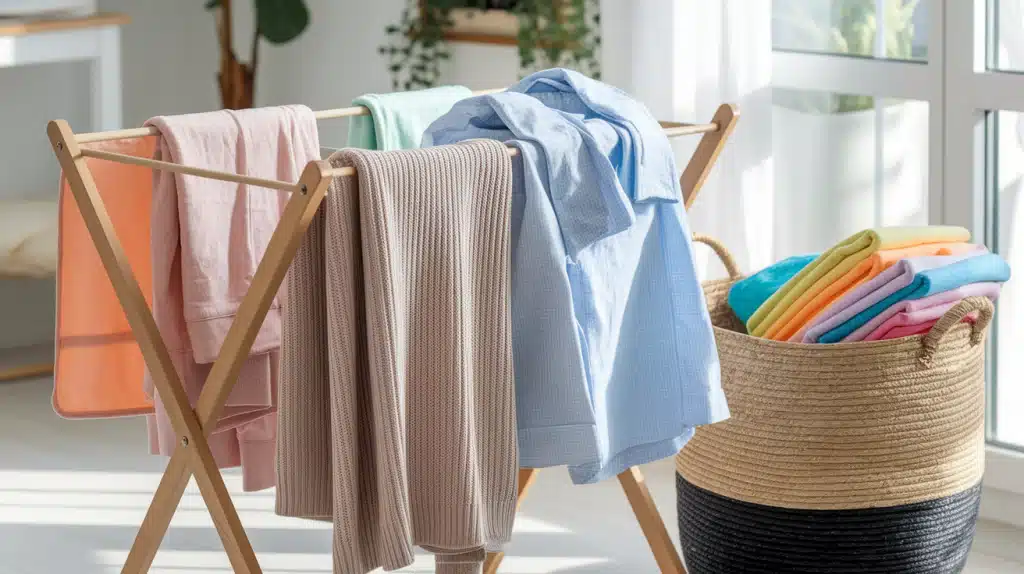Have you ever washed a favorite shirt only to find it faded, stretched, or suddenly too small?
It’s frustrating, but most clothes don’t wear out because they’re badly made.
They wear out because of how we treat them.
The good news is that simple habits can make a difference.
Taking care of what you already own helps you keep your wardrobe fresh, saves money, and even reduces waste.
In this blog, I’ll share practical and easy tips to help your clothes last longer.
These are steps you can start today, with no special skills needed, just small changes that protect fabrics and keep outfits looking new.
13 Tips to Increase the Life of Your Clothes
These are the tried-and-tested tricks and hacks that are not gentle on the clothes you love, but also make them last longer. Read and follow the tips mentioned below:
1. Wash Less Often
Washing too often is the fastest way to wear clothes out.
Each wash cycle breaks down fibers and weakens seams, especially in everyday basics like T-shirts and jeans.
Instead of tossing clothes in the hamper after a single wear, inspect them first.
If they aren’t visibly dirty or smelly, they can usually be reworn. Airing them out overnight often makes them feel fresh again.
You’ll notice colors stay brighter, fabrics hold their shape longer, and your laundry pile shrinks.
2. Read the Care Labels
Those little tags on your clothes are more important than most people think.
They tell you exactly how to treat each fabric so it lasts. Ignoring them can lead to shrunken sweaters or stretched-out tops.
Check labels before washing or ironing. Cotton may handle warm washes, but silk, wool, or rayon often need gentler treatment.
Synthetic blends can warp under high heat. Following the label is a small step that prevents major damage.
3. Use Cold Water
Hot water is harsh on fabric fibers and dyes.
It makes elastic lose its stretch and colors fade faster. Cold water, on the other hand, is gentle and effective for most clothing.
It works well for everyday loads like jeans, T-shirts, and workout clothes. It’s especially helpful for preserving dark colors and delicate fabrics.
Cold water also cuts energy costs, saving you money each time you do laundry.
4. Turn Clothes Inside Out
The outside of your clothes is what people see, so it deserves the most protection.
Friction in the wash can cause fading, lint buildup, and worn spots. Turning items inside out shields the surface.
This is particularly important for dark jeans, printed shirts, or fabrics with texture. Even after dozens of washes, the outside will stay newer for longer.
It’s a tiny habit that pays off big over time.
5. Choose Gentle Detergents
Strong detergents may clean tough stains, but they’re rough on fabrics. Over time, they strip color and leave clothes stiff.
Mild or eco-friendly detergents clean effectively while being kinder to fabric. Use only the recommended amount—extra soap doesn’t mean cleaner clothes, it just leaves residue.
For delicates, liquid detergent is often better because it dissolves faster than powders.
6. Air Dry When You Can
Dryers are fast, but the heat breaks down fibers and causes shrinking.
Clothes also lose softness with repeated tumble drying.
Air drying is gentler. Sweaters laid flat won’t stretch, shirts on hangers keep their shape, and delicate fabrics avoid unnecessary wear.
If you use sunlight, dry clothes in the shade to prevent fading. Reserve the dryer for emergencies or heavy fabrics.
7. Hand Wash Delicates
Some items simply can’t handle machine washing. Lingerie, silk tops, lace dresses, and fine knits benefit from hand washing.
Use cool water with a mild detergent, gently swish items, then rinse.
Instead of wringing, press out water with a towel. Hang or lay flat depending on the fabric. This extra care keeps fragile pieces looking beautiful for years.
8. Store Clothes Properly
Storage affects how long clothes last. Overstuffed closets cause wrinkles, while wire hangers distort fabric.
Use padded or wooden hangers for coats and dresses.
Fold heavy knits like sweaters to avoid stretching. Keep items in a cool, dry area to prevent mold.
For off-season storage, breathable garment bags are better than plastic. They protect fabric while allowing airflow.
9. Rotate Your Wardrobe
Wearing the same shirt every few days makes it wear out fast. Giving items rest days extends their life.
Try organizing clothes by season or by color so you naturally rotate through your wardrobe.
The “hanger trick,” turning unused hangers backward, is another smart method.
Rotation helps you get more out of your closet and prevents favorites from wearing thin too soon.
10. Repair Instead of Replacing
A loose button or tiny tear doesn’t mean it’s time to throw a piece away. Most small issues are simple to fix.
Learn a few basics like sewing on buttons or fixing hems.
For quick fixes, iron-on patches are great for casual wear. High-quality or expensive pieces may be worth a trip to the tailor.
Repairing extends lifespan, saves money, and reduces waste.
11. Avoid Overstuffing Closets and Washers
Clothes need room to breathe. Overcrowded closets cause wrinkles and stretching.
Washers that are too full don’t clean clothes properly and put strain on seams.
Give garments space to hang freely, and always leave room in the drum when washing. Not only will your clothes last longer, but they’ll look neater too.
This one habit makes a noticeable difference in how your clothes age.
12. Sort Dirty Laundry
Mixing all clothes together may be quick, but it damages fabrics. Heavy items like jeans or towels rub against lighter fabrics and cause pilling or fraying.
Always sort laundry by color and fabric type. Wash darks together, lights together, and delicates separately. This helps preserve colors and textures.
Sorting doesn’t take long and saves clothes from unnecessary wear.
13. Buy Quality Clothes
High-quality items last longer because they’re made with better fabrics and stitching. While they may cost more upfront, they hold up through years of wear.
Look for tight seams, natural fibers, and durable finishes. Choose classic designs that won’t go out of style quickly.
Buying fewer but better clothes is an investment in both your wardrobe and the environment.
Conclusion
Taking care of your clothes doesn’t require special skills, just thoughtful habits.
Each small action protects your wardrobe and your wallet.
From gentle washing to smart storage, these strategies turn clothing maintenance into an art form.
Your clothes can stay in good condition for years with consistent care.
Remember, sustainable fashion starts with how we treat our existing clothes.
By extending the life of your wardrobe, you’re not just saving money.
You’re making a positive choice for the environment, reducing textile waste, and developing a more mindful approach to your personal style.
Ready to change your clothing care routine? Which of these tips will you try first to make your clothes last longer?






































